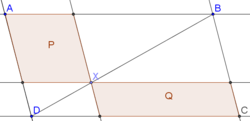Interesting Parallelogram

A point is drawn on the diagonal of a parallelogram . The lines parallel to the sides through are constructed, and quadrilaterals and are formed, as shown in the diagram.
Given that has base and perpendicular height and that the area of is , find the sum of all possible values of the base of .
The answer is 26.
This section requires Javascript.
You are seeing this because something didn't load right. We suggest you, (a) try
refreshing the page, (b) enabling javascript if it is disabled on your browser and,
finally, (c)
loading the
non-javascript version of this page
. We're sorry about the hassle.
By considering congruent triangles we see that the area of P is equal to the area of Q so P has area 48. Then we can form the equations (where b and h are the base and perpendicular height respectively of P):
b h = 4 8
( b + 1 2 ) ( h + 4 ) = 2 0 0
Then:
1 2 h + 4 b = 1 0 4
1 4 4 + b 2 = 2 6 b
( b − 1 8 ) ( b − 8 ) = 0
b = 1 8 , 8
So the answer is 2 6